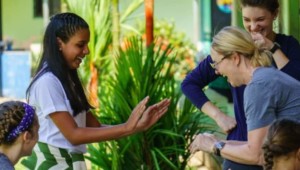Getting Centered by Going to the Edge

By: Elliot Washor
A decades-old meme is presently trending among educators – student-centered learning – also known as student-driven learning, personalization, and students at the center. Doubtlessly, there are other variations. I fear these terms have been captured and held hostage by educators hell-bent on transformation that, using this cliché, replicates what they have already. It is not clear how a system based on rigid and narrow learning standards, testing and centralized systems and structures can aspire to place students at the center. And so, the debasement of language so common in our society continues unabated.
Anthropologist Tim Ingold advises, “Don’t blame words for their incarceration; blame the court of explicators that have passed sentence on them.”
Admonished by Ingold, and yet wishing to contribute to the discourse, I offer here an operational definition of “students at the center.” It might be more accurate to say student at the center, since our Big Picture Learning schools focus on helping each individual student — “One student at a time in a community of learners” — find their center, their stance, and their chosen pathway.
The key for me is to help the learner find and explore their interest(s) deeply, part of which involves exploring the edges of their interests and using that exploration to then “center” their own pathway. The process of centering includes getting edgy—pushing back the boundaries of what is taken for granted. Inspired by Jane Jacobs, a genius in thinking about our cities, might we have every student declare their edge as their center?
A “centering” process involves helping the learner to explore many “edges” to expand the learner’s vision and open up possibilities. Schools then help the student move between the center and these edges, often forming a new center. Schools can prepare the student to engage such center-to-edge, edge-to-center thinking and doing as a lifelong learning process. The best CTE programs and performance schools engage their students in such a process.
This work is guided by a strong evidence base but also by the observations of people who found their center—and keep rediscovering it—by going to the edge. Yo-Yo Ma reflects: “There’s a part of me that’s always charging ahead. I’m the curious kid, always going to the edge.”
I find that we’re good at talking about getting edgy, but too often it’s only lip service. Once the rubber hits the road; namely, once students actually start showing their edginess, we pull them back. As Zat Rana points out in his article, Why Only Rebels Find Real Fulfillment, we tell students:
- “Don’t be an artist because you will never make a living.
- Don’t be an entrepreneur because you’ll probably fail.
- Don’t quit your job to travel because it’s shortsighted.
- Don’t take the road less traveled because it’s risky.”
In Leaving to Learn, which I wrote with my colleague Charles Mojkowski in 2013, we identified 10 expectations that students have of their schools and schooling. They serve for us as criteria for a truly student-focused learning system. As we argued in the book, helping young people find their center by exploring the edges almost always requires that they get out in the real world to engage a wide range of adults doing work and pursuing interests that match the students’ own aspirations.
So what does “centering” on each student actually look like? How do we help each student get a bit edgy based on their interests? How do we help them stretch? To create for themselves images of their potentiality? How can we then wrap an entire learning program around that center?
 The world provides abundant examples of young people going to the edge and declaring it their center. In the civil rights movement, the Little Rock Nine did it. In the environmental movement and in the Women’s movement, it was those youth who broke new ground, just as it was in sports. The X games, surfing, and snowboarding were all started by young people. Similarly, in math, science, and the performing arts, it is our youth and their adult trustees, coaches, and teachers, who are with them to break through boundaries where they find their center at the edge. This navigation of student centering is not at all relegated to only the best in their field but to each and every young person wanting to do their best at the things they love to do.
The world provides abundant examples of young people going to the edge and declaring it their center. In the civil rights movement, the Little Rock Nine did it. In the environmental movement and in the Women’s movement, it was those youth who broke new ground, just as it was in sports. The X games, surfing, and snowboarding were all started by young people. Similarly, in math, science, and the performing arts, it is our youth and their adult trustees, coaches, and teachers, who are with them to break through boundaries where they find their center at the edge. This navigation of student centering is not at all relegated to only the best in their field but to each and every young person wanting to do their best at the things they love to do.
Years ago, a friend Herb Childress wrote a wonderful ethnography that turned into a book titled, Landscapes of Betrayal, Landscapes of Joy. Herb documents his observations of young people who attend a Northern California high school. He notes the happiness the students experience outside school, where they can be themselves and pursue their interests, and the unhappiness and boredom they experience in school. These students maintain a kind of equilibrium between the pull of the outside and the push from the inside that develops because inside and outside learning cannot be blended. There are many ways students get centered, but schools put students in situations where they can do little else but what schools want them to do. How edgy is that?
If we want to be student-centered, I suggest we start where students are productively learning –outside of school at the edges, mingling with people they want to learn from, inventing, discovering, creating, and seeking to understand. They go there to give their lives balance and find their center. They go to find the people and things that matter to them. It is then, as they “muddle through”, that our work with them as teachers and mentors emerges to guide, manage, facilitate, enrich, and instruct.
Recently, I was in touch with one of our former students Ashley Magnus, who is a Harbor Freight Senior Fellow living in Portland, Oregon and is presently working as an apprentice elevator constructor. This is the highest paid trade there is, and for very good reason: it is difficult and dangerous. My conversations with Ashley are just simply amazing. She has always worked, problem-solved, created and thought with her hands, head and heart. In high school, she had an internship restoring pianos. She graduated the Massachusetts College of Arts, became a bike technician, a welder and all the while, in her own words, wherever she worked made herself “indispensable.” I love that.
I believe every school can support student centering by challenging aspects of the traditional school/schooling design that impede deep explorations of interests and edges. By defining and doing student-centered learning this way, we can make a difference for each and every student.
By helping each individual student to find their center by exploring edges, we expand their access to out-of-school learning opportunities, scaffold their exploration of work and career pathways, support their development of social capital, and help them to continually refine their own centers. This, for me, adds further value to the meaning of equity and equal opportunity.
For more, see:
- How Teachers and Leaders Can Promote Personalized Learning
- How Personalized Learning Fosters Trial, Error and a Healthy Dose of Risk
Stay in-the-know with all things edtech and innovations in learning by signing up to receive our weekly newsletter, Smart Update.





0 Comments
Leave a Comment
Your email address will not be published. All fields are required.